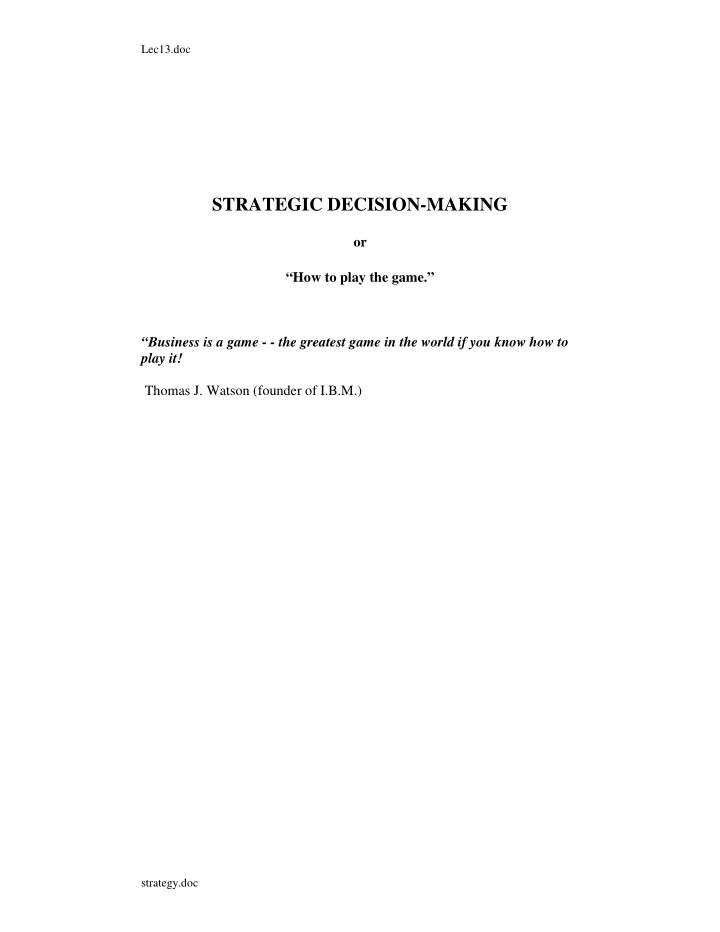

Lec13.doc STRATEGIC DECISION-MAKING or “How to play the game.” “Business is a game - - the greatest game in the world if you know how to play it! Thomas J. Watson (founder of I.B.M.) strategy.doc
A. Elements of a Game Players We will label the n players/agents/participants i=1,...,n Strategy Set S i -- the set of all feasible choices/alternatives/options available to player i. Example 1: Rock, Scissors, Paper (Bau, Jin, Dup) S i = { Paper , Scissors , Rock } Example 2: Open bidding for an art object A strategy is a choice of when to drop out of the bidding. i = { S all possible bids called by the auctioneer } Player i, i=1,...,n plays some strategy s i from his strategy set S i Pure strategy: A single choice from S i Mixed strategy: Player i plays probabilistically, assigning positive probabilities to some of the alternatives in S i Note that while each player must play a single strategy s i in S i , he can choose to play a mixed strategy using some form of randomizing device such as a coin toss or throw of a die. Example: Rock, Scissors Paper As everyone who ever played it quickly realizes, it pays to randomize. HOW? 1
Payoffs If the strategies actually chosen by the n players are s . 2 s ,..., s , then the 1 n outcome of the game leads to a payoff for each player. We write this as u s ( ,..., s ) . i 1 n Rules of play - - Timing of Moves Sequential or simultaneous Equivalently, each player moves sequentially but choices must be made without knowing the choices of those who have already moved. Example: Rock, Scissors, Paper The payoffs for a 2 person game can be conveniently depicted in a matrix as shown in Table B-1. Player 1’s payoffs are denoted in italic and player 2’s in bold Player 2 Payoffs Paper Scissors Rock Paper 0 , 0 -10 , 10 10 , -10 Player 1 Scissors 10 ,- 10 0 , 0 -10 , 10 Rock -10 , 10 10 ,- 10 0 , 0 TABLE B-1: Rock, Scissors, Paper Game in “Normal form” Player 2 Paper Scissors Rock 0 , 0 -30 ,3 0 10 , -10 p Paper Player 1 q Scissors 3 0 ,-3 0 0 , 0 -10 , 10 1-p-q Rock -10 , 10 10 ,- 10 0 , 0 TABLE B-1: Modified Rock, Scissors, Paper Game 2
Description of the Game in “tree” form From the initial “node” of the tree, player 1 chooses an action. The game then continues at one of three nodes for player 2. She then takes her action. The payoffs are indicated at the “terminal” nodes. (0,0) R S (10,-10) 2 P R (-10,10) (-10,10) R S S (0,0) 1 2 P (30,-30) P (10,-10) R S (-30,30) 2 P (0,0) Figure B-1: Tree representation of the game if played sequentially If play is sequential, the tree representation of the game is often very helpful. What will player 2 do? (-10,10) R S 1 (-10,10) P (-30,30) 3
Player 1 is thus indifferent between Rock and Scissors. If player 2 does not know what player 1 has done, we can still represent the game in tree form. (0,0) R S (10,-10) 2 P R (-10,10) (-10,10) R S S (0,0) 1 2 P (30,-30) P (10,-10) R S (-30,30) 2 P (0,0) Figure B-3: Player 2 does not know player 1’s move Player 2 must move not knowing which of the nodes connected by the dotted line she has reached. 4
= − + − − = − − U 2 (Paper) 0( ) p 30( ) 10(1 q p q ) 10 10 p 40 q = + − − − = − + + U 2 (Scissors) 30( ) p 0( ) 10(1 q p q ) 10 40 p 10 q = − + + − − = − + U 2 (Rock) 10( ) 10( ) p q 0(1 p q ) 10 p 10 q RULE : If a player is using a mixed strategy, the strategies which he plays with positive probability must yield the same payoff. In our example, for player 2 to be willing to play both Rock and Paper we require = − − − + = U 2 (Paper) 10 10 p 40 q = 10 p 10 q U (Rock) 2 − = q = Hence 10 40 q 10 , q and so 0.2 Similarly, for player 2 to be willing to play both Scissors and Rock, = − + + = − + = U 2 (Scissors) 10 40 p 10 q = 10 p 10 q U (Rock) 2 p = Thus 0.2 . It follows that player plays Rock with probability 0.6 . End of Lec13 5
Recommend
More recommend